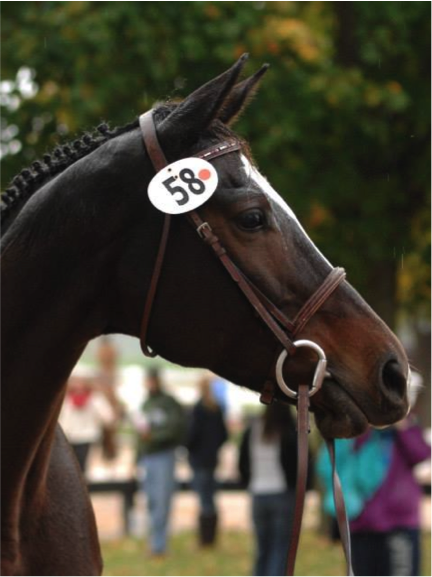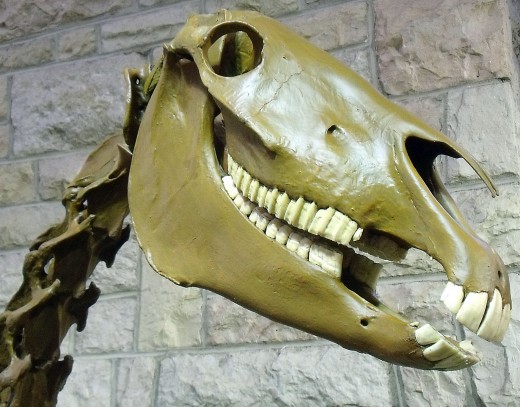Domestication of the Horse in Eurasia
The details concerning the domestication of Equus caballus, the modern horse, have perplexed many scientists for years. Horses have long been used for many purposes, such as transportation, hunting, warfare, meat, milk, and entertainment. However, the exact time period when humans began to domesticate horses, the geographical location of domestication, and the methods by which domestication spread have been difficult to pinpoint. Scientists have used genetic models and studied several factors, such as teeth, bits, bones, and cooking utensils found in ancient societies that point towards the early domestication of the horse in the western Eurasia steppes as early as between 6,000 and 3,500 BCE. This is significant because some of the earliest introductions of horseback riding themed artwork are dated after 2,500 BCE (Brown & Anthony 1998). Having access to the benefits of domesticated horses would have had the potential to completely change the economic and social structure of an ancient society.
The domestication of the horse changed both societies and the horses themselves. Domestication can be defined as “a process whereby founder populations of domestic stock are established de novo” (Warmuth et al., 2012). Domestication is often linked with changes in behavior, bone structure, brain size, and population growth (Marshall & Asa, 2012). It also increases the sociability of the animal, and since horses are naturally social animals, they were good candidates for domestication. Horses are herd-bound creatures that dwell in harem groups with a hierarchy, and since they are prey animals, they tend to be submissive (Marshall & Asa, 2012). Once captured, they would have been relatively easy to tame and to keep, either for riding or food purposes. Societies with horses at their disposal would have had an incredible advantage over those without domesticated horses, especially in terms of travel and warfare. Horses were plentiful in the Eurasian steppes during the Neolithic and Eneolithic ages; in fact, about 99% of animal remains from Botai societies in Kazakhstan consist of horse bones (Hanks, 2010). Therefore, the Botai societies in the Eurasian steppes have been a central area for horse research.
In order to isolate a more exact location and methodology of horse domestication, scientists have used both modern horse genetic data and data from Equus ferus, an extinct wild ancestor of the horse, to recreate several possible scenarios using spatially explicit modeling (Warmuth et al., 2012). These models use statistics from autosomal markers in DNA and other information to determine the most likely explanation of domestication. The data indicates that a location in western central Eurasia, such as Ukraine and Kazakhstan, served as the initial site of horse domestication (Warmuth et al., 2012). The model also shows that domestication most likely spread both through travel of already domesticated animals and the introgression of wild horses (Warmuth et al., 2012). In addition, the data indicates movement between domesticated herds, which would make sense because the owners of the horses would have the ability to travel among societies and trade (Warmuth et al., 2012). Using genetic data from both ancient and modern horses, it is also possible to infer that humans mostly captured mares, or female horses, to add to their already domesticated herd (Warmuth et al., 2012). This is consistent with the fact that in horses, the mitochondrial genome is very diverse, while diversity of the Y chromosome is lacking (Warmuth et al., 2012). This information agrees with existing evidence of horses appearing early in these areas and provides a possible explanation for the geographical origin of horse domestication.
As mentioned previously, archaeological sites in Kazakhstan and the Ukraine, such as Dereivka, have uncovered large amounts of horse remains in ancient Botai societies (Hanks, 2010). While large quantities of bones alone do not indicate domestication, there are other factors that bolster support for the idea of horse domestication in this area. One main point is that humans would most likely find it difficult to kill a lot of horses for meat on a regular basis if they did not have something on which to ride, which would allow them to keep up with the herd of horses (Brown & Anthony, 1998). It would make more sense for humans to first domesticate and enclose the horses, and then to breed them and use them for meat as needed. Archaeologists have also found tools made out of horse bones in Botai villages, among the other remains, making it clear that horses were a big part of their culture in more ways than one (Brown & Anthony, 1998). In addition, horse teeth have been found in Dereivka that contain the oldest known bit wear, which has been radiocarbon dated to a range of 4,200 to 3,700 BCE (Brown & Anthony, 1998). Bit wear, or damage to the teeth due to the use of a bit in the horse’s mouth, has been one of the most convincing pieces of evidence for horse domestication yet.


Bits, mouthpieces that can be made out of metal, leather, hemp, horsehair, or bone, are used to control horses from behind while either riding or driving. When a horse chews at a bit, these materials cause damage to the chewing surfaces of the second premolar teeth (Brown & Anthony, 1998). Since teeth are preserved as well as, if not better than, bones, bit wear is easier to spot in archaeological remains than some other factors. Also, since bits are used for only riding or driving, bit wear is a very good indicator of domestication. Bit wear patterns were reproduced in a study by Brown and Anthony (1998), where modern horses were ridden in bits made from all five different materials. Molds were taken of their lower second premolars and the damage to the teeth was compared. The results support the idea that with more time spent in the bit, bit wear damage to the teeth typically increased, especially when compared with horses who were not ridden in bits (Brown & Anthony, 1998). In addition, bits were most likely used after horses had already been domesticated. It would be reasonable to guess that just a simple noseband was used for control before bits were invented, so the dates for domestication may be even further back in history than the bitting data indicates.
Damage to the teeth through bit use is not the only change in bone structure that would occur with the domestication of the horse. In horses used for riding or driving, stress from the added weight has the ability to cause changes to the skeleton (Bendrey, 2007). Horse metapodia, which are bones in their legs, can change in shape depending on which activities the horse has performed, such as breeding or carrying a rider (Outram et al., 2009). Samples of horse bones were taken from four different sites in Kazakhstan. One sample was from the Botai culture, two samples were from the Tersek culture, and the last sample was from a more recent site named Kent in which the horses were known to be domesticated (Outram et al., 2009). A dozen different measurements of the leg bones were taken and compared to those from the other three sites. While all of the samples had similar bone ratios, the known domesticated horse had slimmer bones, as did the Botai sample (Outram et al., 2009). Similarities between the Botai and domesticated bones, in contrast to the thicker bones from cultures that had not yet domesticated horses, further supports the idea of early horse domestication in Botai culture.
Additional evidence for domestication of the horse in Kazakhstan in the Botai culture can be found in ancient pottery. First, analysis of the carbon isotope ratios is necessary to identify equine fats, although it cannot tell specifically if the fat is from equine milk (Outram et al., 2009). In order to determine if the fat is from horse milk, a compound-specific deuterium isotope analysis of n-alkanoic acids is necessary. This test can detect differences in regular fat cells and milk fats based on indicators of seasonal precipitation changes that are incorporated into the fats (Outram et al., 2009). The results of these tests suggest that pottery at some Botai sites contained horse milk. Keeping animals for their milk is a definite sign of domestication, so this further supports the notion that the large amounts of horse bones found in ancient Botai cultures were there because the people had domesticated the animals. Rather than just simply hunting horses, the Botai people learned how to use horses to their advantage in several ways through domestication.
While there is still much work to be done and much to be learned about the domestication of horses, the Eurasian steppe region where the Botai culture was prevalent has increasing amounts of evidence to support it as the epicenter of horse domestication. Beginning with the discovery of extraordinary amounts of horse remains in Botai groups, it becomes clear that horses played a significant role in their culture. Further evidence in the form of genetic data and models deduce that the origination of horse domestication would have most likely happened in the area that the Botai lived – the western Eurasian steppes (Warmuth et al., 2012). The uncovering of both horse bone tools shows that horses were utilized for more than just food, while the analysis of bit worn teeth provides evidence that the horses were used for either riding or driving. Additionally, a thinner bone structure in certain leg bones found at the Botai site is very similar to the structure of horses that are definitely domesticated. In contrast, thicker bone structures are characteristic of sites where horses had not yet been domesticated. Lastly, the detection of horse milk fats in pottery at Botai sites indicates that horses were kept and milked, which is a sign of domestication. Although it can be difficult to determine an exact date, a large amount of evidence points to the Botai groups as being the first to domesticate horses and begin to use them to their full potential, which can be vital information as a starting point for future studies that will hopefully uncover how these creatures were domesticated and how their use spread around the world.
References
Bendrey, R. (2007). New methods for the identification of evidence for bitting on the horse remains from archaeological sites. Journal of Archaeological Science 34, 1036-1050.
Brown, D. & Anthony, D. (1998). Bit Wear, Horseback Riding and the Botai Site in Kazakstan. Journal of Archaeological Science 25, 331-347.
Hanks, B. (2010). Archaeology of the Eurasian Steppes and Mongolia. Annual Review of Anthropology 39, 469-486.
Marshall, F. & Asa, C. (2013). A Study of African Wild Ass Behavior Provides Insights into Conservation Issues, Domestication Processes and Archaeological Interpretation. Journal of Archaeological Method and Theory 20, 479-494.
Outram, A. et al. (2009). The Earliest Horse Harnessing and Milking. Science 323, 1332-1335.
Warmuth, V. et al. (2012). Reconstructing the origin and spread of horse domestication in the Eurasian steppe. Proceedings of the National Academy of Sciences of the United States of America 109, 8202-8206.
Related Essays
- The Fossil Record and Evolution
A look at how we can use fossils to find out what life looked like in the past, to estimate how long ago certain species existed, and even to depict how animals, such as amphibians, evolved from fish. - Dating of the Shroud of Turin
An analysis of the history of the Shroud of Turin, believed by some to be the burial cloth of Jesus, and an explanation as to why it should not be dated again. - Ancient Ice Man's Last Meal
Analysis of techniques used to determine the famous ancient Ice Man's last meal.
Related Reading
© 2013 ReverieMarie









